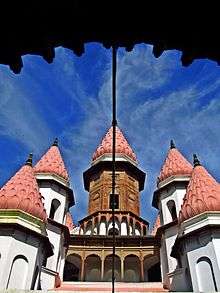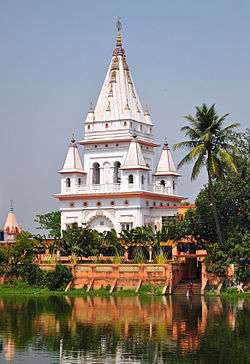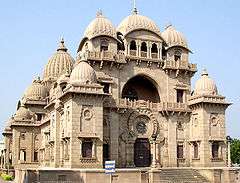Hinduism in West Bengal
| Total population | |
|---|---|
|
64,385,546 million (2011)[1] 70.53 % of Population | |
| Regions with significant populations | |
| Majority in all districts except Murshidabad and Maldah, Uttar Dinajpur district. | |
| Languages | |
| Bengali language |
Hinduism is the largest religious tradition in the Indian state of West Bengal (Paschimbanga) with 70.53 % of the population identifying themselves as Hindus (as of 2011).[2] The Hindus in West Bengal mostly belong to the Vaishnavite, Shakta and Shaivite denominations. The vast majority of Hindus in West Bengal are Bengali Hindus, but a notable section of non-Bengali Hindus also exist, particularly among Marwaris, Biharis, Odias, Gurkhas and various tribal communities. The Hindu population in West Bengal is expected to reach 70,666,257 according to 2021 census report and Hindus will make up 68.0 % of West Bengal population .
Hinduism had existed in the region of Bengal before the 16th century BC and by the 3rd century, Buddhism and Jainism were popular too.[3] Gaur, the first sovereign Hindu kingdom in Bengal with its capital in Karnasubarna in modern-day Murshidabad district, was set up by Shashanka, a Shaivaite king who ruled approximately between 600 AD and 625 AD. The modern structure of Bengali Hindu society was developed during the rule of the Sena dynasty in the 12th century AD. Islam arrived in Bengal in the 13th century and subsequently conquered the region. But while the Muslim saints and rulers successfully spread Islam and established it as the major religion of eastern parts of Bengal (now Bangladesh), they fail do the same in the western parts because of the strong base of Vaishnavism and folk Hinduism in the Rarh and the Gangetic regions of West Bengal where Hinduism remains the predominant religious group till today. West Bengal has been home to several famous religious teachers, including Sri Chaitanya, Sri Ramakrishna, Rammohan Roy, Swami Vivekananda, A. C. Bhaktivedanta Swami Prabhupada and Paramahansa Yogananda who helped to abolish evil practices like sati, dowry, and caste-based discrimination or untouchability that crept into the Hindu society during the Middle Ages. But they also played an important role in the resurgence of Hindu nationalism in Bengal. This inherent Hindu identity was the chief factor in Bengali Hindu Homeland Movement which successfully resisted the plan to create a United Bengal and campaigned for the establishing a separate state of West Bengal in India on the eve of Partition of India in 1947.
The language of the Hindus in West Bengal is Bengali. A large number of Hindu religious texts like biographies of Chaitanya Mahaprabhu, Mangal-kavyas, Bratakathas and Panchalis as well as dharmik writings of modern Bengali philosophers and saints have been produced in Bengali for many centuries.
Kali and Chandi are the most worshipped Hindu goddesses in West Bengal. Worship of Durga, Kali, Shiva, Krishna and other gods and goddesses is also common. Durga Puja is the most important festival of the Hindus in West Bengal as well as the most significant festival of the state in general. Kali Puja is the second major festival of the community and it corresponds to the pan-Indian festival of Diwali. Other major festivals include Kojagari Lakshmi Puja, Dolyatra, Jagaddhatri Puja, Rathayatra, Saraswati Puja, Poila Baishakh, Vishwakarma Puja, Gajan, Poush Parban etc.
Festivals


Hindus in West Bengal observe a number of festivals, hence the Bengali proverb Baro Mase Tero Parbon (বারো মাসে তেরো পার্বণ, "thirteen festivals in twelve months"). The Bengali year begins with Poila Boishakh ceremony on 14th or 15 April. Traditional business establishment commence their fiscal year on this day, with the worship of Lakshmi and Ganesha and inauguration of the Hal Khata (the account books of the Bengali merchants). People dress in ethnic wear and enjoy ethnic food. Poila Baishakh is followed by Rabindra Jayanti or the Birth Anniversary of Rabindranath Tagore which is celebrated as one of the major festivals of the state, Rathyatra and Janmashtami before the commencement of the autumnal festival season which starts with Vishwakarma Puja on the last day of Bengali month of Bhadra. The annual five-day Durga Puja is the biggest and most widely celebrated Hindu festival in West Bengal. Durga Puja is followed by Kojagari Lakshmi Puja, Kali Puja, Bhai Phonta, Jagaddhatri Puja and Kartik Puja. On 1 January Kalpataru Day is observed as an auspicious day associated with Ramakrishna Paramhansa. The winter solstice is celebrated a Paush Sankranti in mid January, followed by Netaji Jayanti or the birth anniversary of Netaji Subhas Chandra Bose and Saraswati Puja. The spring festival of Holi is celebrated in the form of Dolyatra. The year ends with Charak Puja and Gajan.
Temples






Temple architecture in West bengal architecture has assumed a unique identity and evolved into the Bengali terra cotta temple architecture which is also a very common style of Hindu temples in Bangladesh. Due to lack of suitable stone in the alluvial Gangetic delta, the temple makers had to resort to other materials instead of stone. This gave rise to using terra cotta as a medium for temple construction. Terra-cotta exteriors with rich carvings are a unique feature of Bengali temples. The town of Vishnupur in West Bengal is renowned for this type of architecture.
Usually a part of the intended total motif was carved by hand on one side of a brick and then baked. While under construction, these carved bricks were arranged to make up the entire motif.
The Bengali style of temple is not luxurious. Rather, most are modeled on simple thatched-roof earthen huts used as dwellings by commoners. This can be attributed to the popularity of bhakti cults which taught people to view gods as close to themselves. Thus, various styles like do-chala, jor-bangla, char-chala, and aat-chala sprang up. However, there is also a popular style of building known as Navaratna (nine-towered) or Pancharatna (five-towered) in Bengal which is more luxurious than the Chala buildings. A typical example of Navaratna style is the Dakshineswar Kali Temple. The Shiva temples of rural Bengal has significantly impacted on the architectural style of Kalighat Temple, one of the oldest Hindu temples of India. The famous Birla Temple of Kolkata, built in 1996, has a unique blend of temple architecture of Odisha with Rajasthani temple arts.
Population
Population by district
| # | District | Total population | Hindu population | % |
|---|---|---|---|---|
| 1 | North 24 Parganas | 10,009,781 | 7,352,769 | 73.46% |
| 2 | Barddhaman | 7,717,563 | 6,008,472 | 77.85% |
| 3 | South 24 Parganas | 8,161,961 | 5,155,545 | 63.17% |
| 4 | Paschim Medinipur | 5,913,457 | 5,056,953 | 85.52% |
| 5 | Hugli | 5,519,145 | 4,574,569 | 82.89% |
| 6 | Purba Medinipur | 5,095,875 | 4,343,972 | 85.24% |
| 7 | Nadia | 5,167,600 | 3,728,482 | 72.15% |
| 8 | Haora | 4,850,029 | 3,535,844 | 72.90% |
| 9 | Kolkata | 4,496,694 | 3,440,290 | 76.51% |
| 10 | Jalpaiguri | 3,872,846 | 3,156,781 | 81.51% |
| 11 | Bankura | 3,596,674 | 3,033,581 | 84.34% |
| 12 | Puruliya | 2,930,115 | 2,373,120 | 80.99% |
| 13 | Murshidabad | 7,103,807 | 2,359,061 | 33.21% |
| 14 | Birbhum | 3,502,404 | 2,181,515 | 62.29% |
| 15 | Koch Bihar | 2,819,086 | 2,087,766 | 74.06% |
| 16 | Maldah | 3,988,845 | 1,914,352 | 47.99% |
| 17 | Uttar Dinajpur | 3,007,134 | 1,482,943 | 49.31% |
| 18 | Darjiling | 1,846,823 | 1,366,681 | 74.00% |
| 19 | Dakshin Dinajpur | 1,676,276 | 1,232,850 | 73.55% |
| West Bengal (Total) | 91,276,115 | 64,385,550 | 70.54% |
Trends
| Census year | % of total population | Decadal growth |
|---|---|---|
| 1951 | 78.45% | NA |
| 1961 | 78.80% | 32.63% |
| 1971 | 78.11% | 25.75% |
| 1981 | 76.96% | 21.37% |
| 1991 | 74.72% | 21.09% |
| 2001 | 72.47% | 14.23% |
| 2011 | 70.53% | 10.80% |
Economies and Business
The Bengali Hindus of West Bengal have their mainstay in trade and business. This ethnic minority has been home to major industrialists worldwide. Large number of West Bengali Hindus have settled outside India. However, the largest section of urban middle and upper-middle class Hindus are employed in the service sector and numerous professional fields like law, medicine, academics, engineering, journalism, liberal arts, corporate job, banking etc. On the other hand, most of the rural and semi-rural people are engaged in agriculture, cottage industry and small-scale businesses.
The literacy level of Bengali Hindus in Bengal and other parts of the world is very high. The higher literacy level combined with economic prosperity and flexible outlook have given Hindus in Bengal a clear edge over other communities, especially Muslims.
Noted West Bengali Hindu industrialists include:
- Raja Nabakrishna Deb of Shovabazar
- Gouri Sen
- Gourmohan Dutta of GD Pharmaceuticals-manufacturers
- Hari Ghosh
- Banamali Sarkar
- Gobindram Mitter
- Prasanna Coomar Tagore
- Ramanath Tagore
- Prince Dwarkanath Tagore
- Rajen Mookerjee
- Sir Biren Mookerjee
- Rajat Kumar Gupta
- Purnendu Chatterjee of The Chatterjee Group & Haldia Petrochemicals
- Prashant Mukherjee
- Sadhan Dutt
- Amar Gopal Bose of Bose Corporation
- Aveek Sarkar
See also
References
- ↑
- ↑ "Data on Religion". Census of India (2001). Office of the Registrar General & Census Commissioner, India. Archived from the original on 12 August 2007. Retrieved August 26, 2006.
- ↑ Sen, Sukumar (1999). "Dharme" [The Religion]. Banga-Bhumika [An Introduction to the History of Bengal] (in Bengali) (1st ed.). Kolkata: Paschimbanga Bangla Akademi. pp. 104–05. ISBN 81-86908-97-8.
- ↑ Population by religious community: West Bengal. 2011 Census of India.
- ↑ B.P. Syam Roy (28 September 2015). "Bengal's topsy-turvy population growth". The Statesman.
